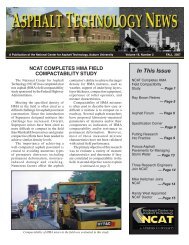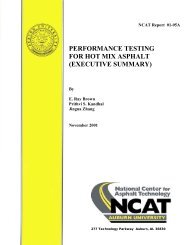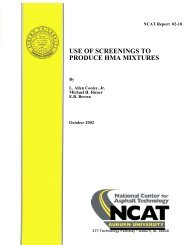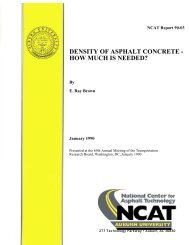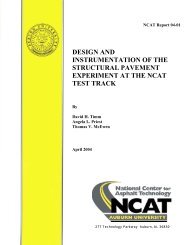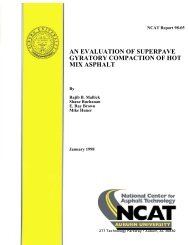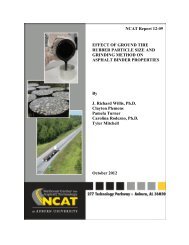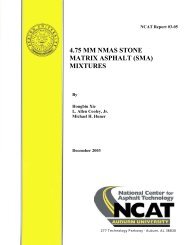A Review of Aggregate and Asphalt Mixture Specific Gravity ...
A Review of Aggregate and Asphalt Mixture Specific Gravity ...
A Review of Aggregate and Asphalt Mixture Specific Gravity ...
Create successful ePaper yourself
Turn your PDF publications into a flip-book with our unique Google optimized e-Paper software.
In 2000, K<strong>and</strong>hal et al. (7) conducted a research project to develop a new methodusing automated equipment for determining the SSD condition <strong>of</strong> fine aggregate. Thework was based on basic principles <strong>of</strong> thermodynamics that had been studied by Dana<strong>and</strong> Peters (8) <strong>of</strong> the Arizona Department <strong>of</strong> Transportation. The equipment measures thetemperature gradient <strong>of</strong> the incoming <strong>and</strong> outgoing warm air blown into a rotating drum.The SSD condition is achieved when the thermal gradient drops suddenly. While themethod shows promise, more effort is needed to improve the repeatability <strong>and</strong>reproducibility <strong>of</strong> the test.Recently, several studies have been conducted to compare the AggPlus systemusing the CoreLok vacuum-sealing device to the AASHTO T 84 procedure. In 2004, Hall(4) conducted an evaluation study in which one operator performed all testing <strong>of</strong> fivereplicates for each <strong>of</strong> five fine aggregate materials using both test methods. He reportedthat G sb results for some fine aggregates determined using the two methods weresignificantly different at the 95% confidence level. The AggPlus system was alsoevaluated in a round-robin study conducted with 12 laboratories by Prowell <strong>and</strong> Baker (9)using six materials, four crushed, <strong>and</strong> two natural fine aggregate sources. The study foundthat G sb results using the two methods were statistically different for three <strong>of</strong> sixaggregates, including limestone, washed diabase, <strong>and</strong> blast furnace slag. The differenceswere believed to be due to over-drying the aggregate. This lead to inaccurate results forangular materials with high dust contents using the AASHTO T 84 procedure. Theprecision indices <strong>of</strong> the CoreLok method were not as good as those <strong>of</strong> AASHTO T 84,but the authors suggested that the precision would be improved as technicians becamemore familiar with the CoreLok method.Another evaluation study was conducted by Sholar et al. (6) <strong>of</strong> the FloridaDepartment <strong>of</strong> Transportation. One operator tested two replicates for each <strong>of</strong> sevenaggregates using the CoreLok method <strong>and</strong> AASHTO T 84. The study found that theCoreLok <strong>and</strong> AASHTO T 84 gave similar G sb results for three low absorptive graniteaggregates but different G sb values for four high absorptive limestone aggregates. TheCoreLok method produced slightly higher G sb values for the granite aggregate <strong>and</strong> lowerG sb values for limestone aggregate. For the limestone aggregate, the average difference inG sb between the two test methods was 0.040, which would result in a change in VMA <strong>of</strong>1.4%. The repeatability <strong>of</strong> G sb results using the CoreLok was judged to be slightly betterthan that <strong>of</strong> AASHTO T 84.The most recent evaluation study was conducted by Cross et al. (10) in 2006using 14 fine aggregates <strong>of</strong> various types, including limestone, s<strong>and</strong>stone, granite,rhyolite, <strong>and</strong> natural s<strong>and</strong>. They reported that G sb results using the CoreLok <strong>and</strong>AASHTO T 84 methods were significantly different, <strong>and</strong> the CoreLok tended to producehigher G sb values.In summary, studies have shown that G sb results using the CoreLok method arestatistically different from those <strong>of</strong> the AASHTO T 84 procedure for a variety <strong>of</strong>aggregate sources. Some studies have shown that the precision <strong>of</strong> the CoreLok is not as11




